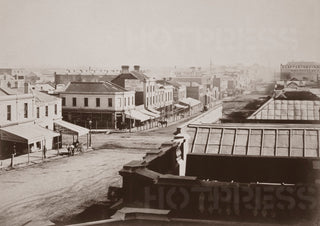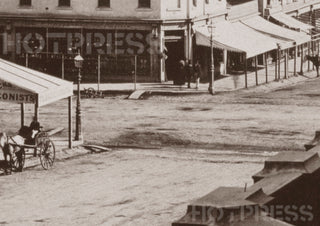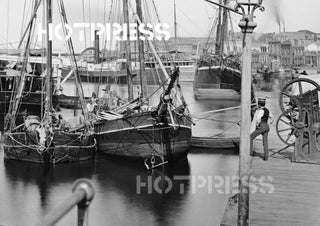1858 Collins Street Looking West across Swanston Street
Description
A very quiet day on Collins Street, taken in 1858, looking West along Collins Street, from just east of the Swanston Street intersection. The town looks deserted, similar to many other photographs from this period, but in fact anything that wasn't completely stationary for at least a couple of minutes was registered as a blur in these early days of photography.
This photograph has been taken from an upper floor of a building on the north-side of Collins Street, looking west over the intersection with Swanston Street. The roof in the foreground is that of the first Melbourne Town Hall.
Neave's Buildings is on the south-east corner and Walter Powell (ironmonger), is situated in the building on the south-west corner of the intersection. Further along on the south side of Collins Street are Gregory's restaurant, Samuel Finley and Co. (drapery importers and silk merchants), and in the distance, just west of Elizabeth Street, are the offices of the Colonial Insurance Company. Clapperton, Findlay and Co. (drapers and warehousemen) have their large premises to the right of the photograph.
Victoria was in the middle of a major gold rush and Victoria's population had grown from 75,000 in 1851 to over 500,000 by 1861, making up 47% of Australia's population.
Looking at this image, it's hard to believe that Melbourne was barely 20 years old. Three years before this photo was taken the Melbourne Cricket Club was settled in at the MCG. Just 3 years after this photo was taken the first Melbourne Cup was run. The first Australian Rules Football match was played in Melbourne in the year this photo was taken, 1858.
All text © HotPress
Photograph by Richard Daintree 1832-1878; Antoine Fauchery 1823-1861.
Notes from the State Library of Victoria tell us that the image shows a "View of Collins Street looking west across Swanston Street."
This is a digitally retouched reproduction of the original held by the State Library of Victoria. All prints are reproduced without the HOTPRESS watermarks.
Our team of conservators have worked on a high resolution digital image in order to remove blemishes and artifacts such as stains, mould, scratches and damage caused by the handling of the original. We strive to provide authentic representations of the original work that are suitable for enlargements that retain the tones and character of the original.
Description
A very quiet day on Collins Street, taken in 1858, looking West along Collins Street, from just east of the Swanston Street intersection. The town looks deserted, similar to many other photographs from this period, but in fact anything that wasn't completely stationary for at least a couple of minutes was registered as a blur in these early days of photography.
This photograph has been taken from an upper floor of a building on the north-side of Collins Street, looking west over the intersection with Swanston Street. The roof in the foreground is that of the first Melbourne Town Hall.
Neave's Buildings is on the south-east corner and Walter Powell (ironmonger), is situated in the building on the south-west corner of the intersection. Further along on the south side of Collins Street are Gregory's restaurant, Samuel Finley and Co. (drapery importers and silk merchants), and in the distance, just west of Elizabeth Street, are the offices of the Colonial Insurance Company. Clapperton, Findlay and Co. (drapers and warehousemen) have their large premises to the right of the photograph.
Victoria was in the middle of a major gold rush and Victoria's population had grown from 75,000 in 1851 to over 500,000 by 1861, making up 47% of Australia's population.
Looking at this image, it's hard to believe that Melbourne was barely 20 years old. Three years before this photo was taken the Melbourne Cricket Club was settled in at the MCG. Just 3 years after this photo was taken the first Melbourne Cup was run. The first Australian Rules Football match was played in Melbourne in the year this photo was taken, 1858.
All text © HotPress
Photograph by Richard Daintree 1832-1878; Antoine Fauchery 1823-1861.
Notes from the State Library of Victoria tell us that the image shows a "View of Collins Street looking west across Swanston Street."
This is a digitally retouched reproduction of the original held by the State Library of Victoria. All prints are reproduced without the HOTPRESS watermarks.
Our team of conservators have worked on a high resolution digital image in order to remove blemishes and artifacts such as stains, mould, scratches and damage caused by the handling of the original. We strive to provide authentic representations of the original work that are suitable for enlargements that retain the tones and character of the original.


